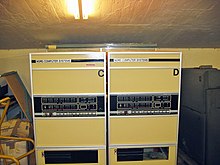NORTH-10
The NORD-10 was a minicomputer from Norsk Data in 16-bit architecture , freely programmable in several languages, equipped with a real-time core and a time slot control for application programs. The NORD-10 was introduced in 1973, the second generation NORD-10 / S also mastered caching , paging and contained further improvements.
The central processing unit contained a microprocessor - this is not a typographical error, because, contrary to the current view, the operating manual introduced the term “microprocessor” as an abbreviation of “ microcode processor ”. It was possible to exchange the instruction set for application programs as a microcode program in the CPU. The basic set for inputs / outputs, boot loader and system test were housed in 1 K ROM. The exchange of the microcode set was also possible for customers.
The NORD-10 had a memory management with hardware-supported paging for memory expansion from 64 to 256 K of 16-bit words. The memory protection comprised two levels with control for each page and mode of the program. The interrupt system comprised 16 hard interrupts, each of which had its own set of registers in the CPU core.
The central processing unit consisted of 24 boards, eight of which were for input / output. The register set comprised a total of 160 registers, 128 of which were for the user programs, divided into eight registers each for the 16 system levels. In each of the subdivisions there were six general registers, a program counter and a status register. In addition to bit operations and byte operations, the processor also mastered operations for 16-bit, 32-bit integers and 48-bit floating point numbers.
The main memory was managed in units of 8 K × 16 bits, each on its own circuit board, which was housed in a 19-inch rack. Each rack could accommodate eight of these 8K modules. The memory management with paging made it possible to go beyond the 64 K and then to address 256 K with 18-bit addresses.
The system software comprised the NORD-TSS (time-shared system) and a real-time system SINTRAN III . The minimal configuration contained SINTRAN III together with a NORD-10 and 8 K. Applications for NORD-TSS could be written in FORTRAN IV , BASIC , MAC Assembler , NODAL , NORD-PL or QED (text editor).
There are a number of NORD-10 and NORD-10 / S still in existence, most of them in working order and some in the hands of NODAF . The restoration of the systems will be carried out both in Oslo at NODAF and in Trondheim at the Technical and Natural Sciences University of Norway (NTNU).
The forerunner was the NORD-1 and the successor was the NORD-100 .
swell
- Jan Aske Børresen: Inside NORD-10 . A / S Norsk Data-Electronicsk, ND-nytt.
